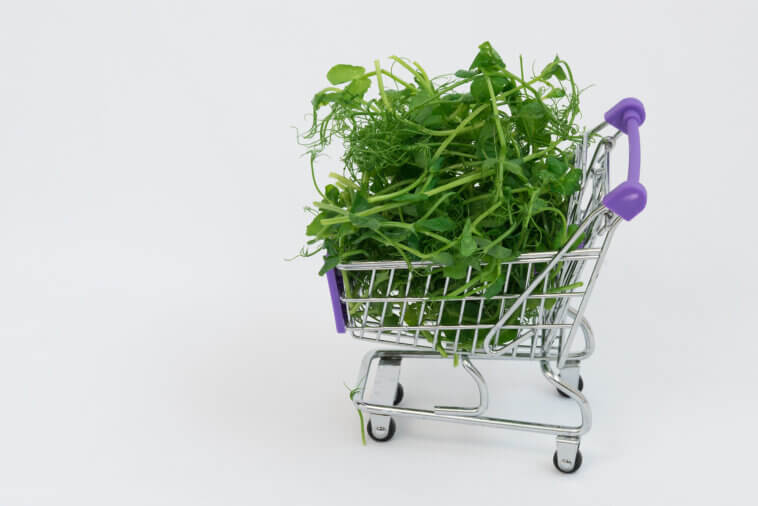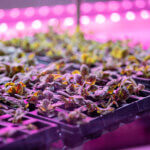Table of Contents
I've been absolutely fascinated by the recent surge in popularity of microgreens, and I can't help but be drawn in by their vibrant colors, incredible flavors, and outstanding nutritional benefits. It's amazing to see how these tiny greens have managed to make their way into so many dishes, from salads to sandwiches and even smoothies.
However, like many others, I've often wondered about the cost of microgreens. So, I decided to dig deep into this topic and share what I've discovered.
Let me take you on a journey through the world of microgreens pricing, exploring the various factors that influence their cost and shedding light on the current market trends. Along the way, I'll also share some valuable tips on how you can grow your own microgreens affordably.
By the end of this exploration, I hope you'll have a clearer picture of what to expect when it comes to microgreens prices and how to embark on your own exciting microgreens adventure without breaking the bank.
Factors Affecting Microgreens Prices
Variety and Type of Microgreens
The type of microgreen you choose significantly impacts its price. Some microgreens are more expensive than others due to factors such as rarity, difficulty in cultivation, and demand. For example, microgreens like arugula, radish, and sunflower tend to be more affordable because they are easier to grow and have a shorter cultivation period. On the other hand, microgreens like saffron, truffle, and shiso are considered specialty varieties and can command premium prices due to their unique flavors and limited availability.
Growing Method
The method used to grow microgreens can also affect their price. There are two primary methods: soil-based and hydroponic. Soil-based cultivation tends to be more cost-effective because it requires fewer specialized materials and equipment. Hydroponic systems, which involve growing microgreens in nutrient-rich water without soil, can be more expensive to set up initially. However, they can produce higher yields and may lead to higher overall profitability, potentially offsetting the initial investment.
Seasonality
Microgreens are influenced by seasonal variations in price, much like other fresh produce. Prices can fluctuate based on the availability of certain varieties throughout the year. In-season microgreens are generally more affordable, while out-of-season options may be priced higher due to increased production costs. Seasonal availability can also influence the choice of microgreens for growers and buyers alike.
Local vs. Commercial Production
The source of your microgreens can also impact their price. Microgreens grown locally often have lower transportation costs and can be more affordable than those shipped from distant locations. Supporting local growers not only reduces the environmental footprint but can also result in fresher and more cost-effective microgreens.
Commercially produced microgreens, on the other hand, may have higher prices due to economies of scale, but they are widely available year-round. The choice between local and commercial sources depends on your preferences, budget, and access to fresh microgreens.
Packaging and Presentation
The way microgreens are packaged and presented can influence their price. Microgreens sold in premium packaging with attractive labels and branding may be priced higher compared to those in simpler packaging. Presentation can make a significant difference in the perceived value of the product, and some consumers are willing to pay more for an aesthetically pleasing package.
Organic vs. Conventional
The choice between organic and conventional microgreens can also affect pricing. Organic microgreens are grown without synthetic pesticides or fertilizers, and the certification process can add to production costs. As a result, organic microgreens are typically more expensive than their conventionally grown counterparts. However, they are in high demand among health-conscious consumers who prioritize organic products.

Trends in Microgreens Pricing
Microgreen pricing trends have evolved over the years, reflecting changes in consumer preferences, market dynamics, and agricultural practices. Here are some notable trends in microgreens pricing:
Increasing Popularity
The growing awareness of the health benefits and culinary versatility of microgreens has led to an increase in demand. As more consumers incorporate microgreens into their diets, the overall demand has surged, potentially affecting prices. Growers have responded to this trend by expanding their production, helping to stabilize prices to some extent.
Specialized Microgreen Farms
Specialized microgreen farms have emerged as dedicated growers focus on producing a wide variety of high-quality microgreens. These farms often prioritize sustainability, organic cultivation, and innovative growing techniques, which can contribute to slightly higher prices compared to mass-produced options. However, consumers are often willing to pay more for the unique flavors and varieties offered by specialized growers.
Price Competition
As the microgreens market grows, competition among growers and suppliers has intensified. This competition can lead to price fluctuations as producers seek to attract customers with competitive pricing. Buyers may find varying prices for the same microgreens depending on the supplier and location.
Seasonal Variations
The availability of certain microgreens varies by season, leading to seasonal price fluctuations. Some varieties may be more expensive when they are out of season or less abundant. Consumers who want to save on microgreens should consider purchasing in-season varieties or growing their own.
Premium Microgreens
Some microgreens are considered premium varieties due to their unique flavors, colors, or nutritional profiles. These premium microgreens often command higher prices and are popular choices for chefs and food enthusiasts looking to elevate their dishes.
Health Benefits of Microgreens
Microgreens may be small in size, but they pack a mighty nutritional punch. These tiny greens, harvested at an early stage of growth, are teeming with vitamins, minerals, antioxidants, and other beneficial compounds that can have a significant impact on your health. Here are some of the key health benefits of incorporating microgreens into your diet:
Nutrient Density
Microgreens are exceptionally rich in essential nutrients. They often contain higher concentrations of vitamins and minerals than their mature counterparts. For instance, microgreen broccoli can contain up to 40 times more nutrients by weight than fully grown broccoli. This means you can get a substantial portion of your daily nutrient requirements from a small serving of microgreens.
Antioxidant Power
Many microgreens, such as red cabbage and cilantro, are loaded with antioxidants like vitamin C, vitamin E, and beta-carotene. Antioxidants play a crucial role in neutralizing harmful free radicals in your body, helping to protect your cells from oxidative stress and reduce the risk of chronic diseases.
Improved Digestion
Microgreens can be a valuable source of dietary fiber, which aids in digestion and promotes a healthy gut. Fiber helps prevent constipation, supports regular bowel movements, and may even contribute to a reduced risk of gastrointestinal disorders.
Weight Management
Due to their high nutrient content and low calorie count, microgreens can be an excellent addition to a weight management plan. They provide essential nutrients without adding many calories, helping you feel fuller for longer and potentially reducing overall calorie intake.
Enhanced Immune Function
Microgreens contain vitamins and minerals that are vital for a robust immune system. Vitamin C, for example, is known for its immune-boosting properties. By regularly consuming microgreens, you can help fortify your body's defenses against infections and illnesses.
Heart Health
Some microgreens, like beet greens and Swiss chard, are rich in potassium and folate, which are associated with heart health. Potassium helps regulate blood pressure, while folate supports the reduction of homocysteine levels in the blood, which is a risk factor for cardiovascular disease.
Reduced Risk of Chronic Diseases
The antioxidant and anti-inflammatory properties of microgreens may contribute to a decreased risk of chronic diseases, such as diabetes, cancer, and heart disease. Including a variety of microgreens in your diet can be a proactive step towards better long-term health.
Eye Health
Certain microgreens, including those from the brassica family (e.g., kale and broccoli), are rich in lutein and zeaxanthin, carotenoids that are beneficial for eye health. These compounds help protect the eyes from harmful ultraviolet rays and may reduce the risk of age-related macular degeneration and cataracts sunflower shoots microgreens product profile.
Sustainable Practices in Microgreen Cultivation
Adopting sustainable practices in microgreen cultivation is not only environmentally responsible but can also lead to healthier and more cost-effective growth. Here are some sustainable practices to consider:
- Composting: Utilize composting to recycle organic matter, such as used microgreen growing medium and plant residues. This produces nutrient-rich compost that can enhance soil fertility in your garden.
- Water Conservation: Implement efficient watering techniques, such as drip irrigation or a timed watering system, to minimize water wastage during microgreen cultivation.
- Organic Pest Control: Use organic and natural methods for pest control, such as introducing beneficial insects or using neem oil, to avoid the use of harmful chemicals.
- Energy-Efficient Lighting: If you are growing microgreens indoors, opt for energy-efficient LED grow lights, which consume less electricity and generate less heat compared to traditional lighting.
- Sustainable Packaging: If you sell microgreens commercially, consider eco-friendly packaging options made from recycled or biodegradable materials to reduce your environmental impact.
Cost-Effective Microgreens Growing Tips
Growing your own microgreens can be a cost-effective way to enjoy these nutritious greens regularly. Here are some tips to help you get started:
Choose Easy-to-Grow Varieties
If you're new to microgreen cultivation, start with easy-to-grow varieties like arugula, mustard, and radish. These varieties require minimal care and can provide a good introduction to microgreens gardening.
Use Affordable Growing Mediums
Select cost-effective growing mediums such as potting mix, coconut coir, or vermiculite. These mediums are readily available and can be used for multiple rounds of microgreens cultivation organic nongmo bestselling microgreens.
DIY Containers
Consider using repurposed or DIY containers for growing microgreens. Plastic trays, shallow wooden boxes, or even recycled containers can work well for microgreen cultivation. Ensure they have proper drainage to prevent waterlogged soil.
Natural Light or LED Grow Lights
Microgreens require adequate light for healthy growth. If you don't have access to natural sunlight, invest in energy-efficient LED grow lights. These lights can be more cost-effective in the long run, as they consume less electricity and provide consistent light.
Regular Harvesting
Harvest your microgreens at the right time to maximize yields and flavor. Waiting too long can result in overcrowded trays and reduced quality. Harvesting at the right stage also ensures you can reuse your growing medium for subsequent batches.
Regrow or Replant
Many microgreens can be regrown from the same tray after harvesting. Some varieties, like radish and lettuce, can produce a second crop with proper care. Reusing the growing medium and trays can save you money over time great greens microgreens.
Buy Seeds in Bulk
Purchase microgreen seeds in bulk to take advantage of cost savings. Seeds are often available in larger quantities at a lower price per gram or ounce.
Vermicomposting
Dispose of used microgreen growing mediums and plant residues through vermicomposting (composting with worms). This sustainable practice not only reduces waste but also provides nutrient-rich compost for your garden organic pea microgreens.
Exploring Unique Microgreen Varieties
Microgreens, often referred to as nature's petite powerhouses, introduce an array of captivating and lesser-known varieties that can truly elevate your culinary journey. Delve into the fascinating realm of these miniature greens and discover their unique qualities:
- Amaranth: Amaranth microgreens boast vibrant red or green leaves, offering a mild, earthy flavor profile. Beyond their delightful taste, these tiny greens are brimming with essential vitamins and minerals. Incorporate them into your repertoire to enhance the vibrancy of salads and sandwiches.
- Purslane: Purslane microgreens captivate the palate with their succulent leaves, imbued with a refreshing lemony tang. As an added bonus, they are a rich source of omega-3 fatty acids, making them an excellent choice for salads or as a zesty garnish to complement seafood dishes.
- Sorrel: Sorrel microgreens introduce a sharp, tangy flavor reminiscent of lemon zest. These miniature wonders can infuse salads, soups, and sauces with a lively and refreshing kick, transforming your dishes into culinary masterpieces.
- Lemon Basil: Lemon basil microgreens exude a delightful citrusy aroma and a zesty taste that's a perfect match for seafood, pasta, and Thai cuisine. Elevate your culinary creations with this aromatic gem, adding a burst of fresh flavor to your favorite dishes.
- Tatsoi: Tatsoi microgreens offer tender, spoon-shaped leaves with a mild, mustard-like flavor. These versatile greens are ideal for enhancing the complexity of salads, adding a unique twist to stir-fries, or serving as a sophisticated garnish for sushi presentations.
FAQs (Frequently Asked Questions) About Microgreens
What are microgreens, and how are they different from sprouts and baby greens?
Microgreens are young, edible plants that are harvested at an early stage of growth, typically when they have developed their first true leaves. They differ from sprouts, which are harvested even earlier, as well as from baby greens, which are more mature and usually consist of the entire plant.
Are microgreens the same as herbs?
No, microgreens are not the same as herbs. While both microgreens and herbs are used to add flavor to dishes, herbs are typically the leaves or stems of fully grown plants, whereas microgreens are harvested at a much younger stage and include a wider variety of plant parts, including leaves, stems, and sometimes even cotyledons (seed leaves).
What are the most popular types of microgreens?
Some of the most popular microgreen varieties include arugula, basil, cilantro, broccoli, radish, sunflower, pea shoots, and mustard. However, there are many more varieties to explore, each with its own unique flavor and nutritional profile.
How do I store microgreens to keep them fresh?
To keep microgreens fresh, store them in airtight containers or plastic bags in the refrigerator. Place a paper towel in the container or bag to absorb excess moisture and prevent wilting. Properly stored, microgreens can stay fresh for up to a week.
Can I grow microgreens indoors?
Yes, microgreens can be successfully grown indoors. They require minimal space, making them a great choice for indoor gardening. You can use trays, pots, or hydroponic systems to cultivate microgreens on a windowsill, countertop, or under grow lights.
What is the best growing medium for microgreens?
Common growing mediums for microgreens include potting mix, coconut coir, vermiculite, and soilless seed-starting mix. The choice of medium depends on your preference, availability, and specific growing conditions. Ensure that the medium is well-draining and free of contaminants.
Do microgreens require a lot of sunlight?
Microgreens do require adequate light for healthy growth. While natural sunlight is ideal, they can also thrive under artificial grow lights, such as LED or fluorescent bulbs. Provide 12-16 hours of light per day for optimal results.
Are microgreens safe to eat raw?
Yes, microgreens are safe to eat raw, and they are often used as garnishes, salad greens, and sandwich fillings. However, it's essential to wash them thoroughly before consumption to remove any potential contaminants.
Are there any potential allergens in microgreens?
While allergies to microgreens are rare, some people may have sensitivities to certain varieties. If you have known allergies to specific plants, exercise caution when trying new microgreen varieties, and consult with a healthcare professional if you have concerns.
Can I regrow microgreens after harvesting?
Some microgreens, such as radish and lettuce, can be regrown from the same tray after harvesting the first crop. However, the yield and quality of the subsequent crops may vary. Be sure to keep the growing medium moist and provide adequate light for regrowth.
Conclusion
My exploration of the world of microgreens has been a personal and eye-opening journey. These tiny greens, bursting with flavor and nutrition, have not only enriched my culinary experiences but also deepened my understanding of sustainable living. Discovering the factors influencing microgreens pricing has made me appreciate the nuances of this thriving market, allowing me to make informed choices as a consumer.
The health benefits of microgreens, their sustainability, and the joy of growing them at home have all left a lasting impact on my life. They've become a staple in my daily diet, providing me with a nutrient-packed and eco-conscious way to enjoy fresh greens.
Furthermore, the world of unique microgreen varieties has opened up a world of flavors and possibilities that continue to inspire my culinary adventures. My microgreens journey has truly been a delightful fusion of taste, health, sustainability, and affordability.




Comments
Loading…